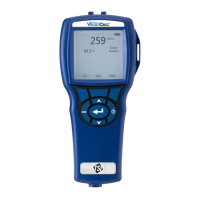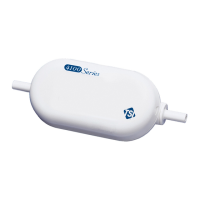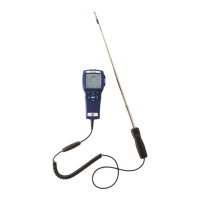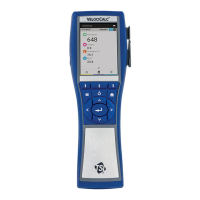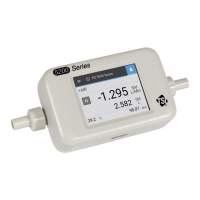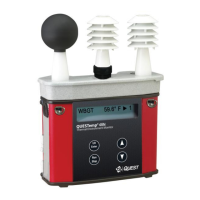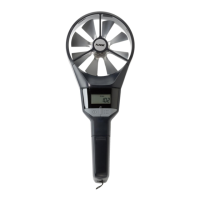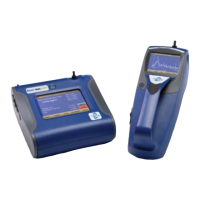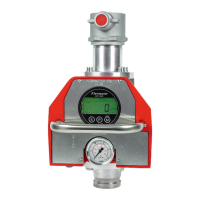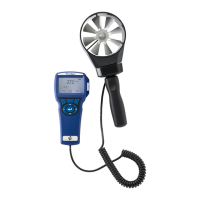Version 1.7 (June 2017)
TSI Flowmeters Ltd.
5
MAINTENANCE & TROUBLE-SHOOTING
5.1 BATTERY MAINTENANCE
Battery pack operating time is 10 hours continuous
usage. The batteries can be recharged at any time
using the mains charger supplied. Connect the battery
charger to the Flowmaster battery charger socket. It is
better to top up charge the batteries at regular
intervals than to allow them to discharge fully.
The batteries can be left on continuous charge when
the Flowmaster is not in use. The batteries have an
operating life of ten years and will need to be replaced
thereafter. The operating time will reduce as the
batteries age.
EFFECT OF CONTINUOUS METER USE ON
BATTERY LIFE
The type of battery in use on the Flowmaster 250 is
NiMH type. This battery type is designed for regular but
intermittent use. It is not designed for deep discharge
such as would happen were the Flowmaster repeatedly
left powered on for eight to ten hours per day. In
these circumstances, the battery life would be reduced
to ten months. Battery replacement under these
circumstances is not covered under warranty.
Should your working procedures require that the
Flowmaster is powered on for up to eight hours per
day, please contact TSI Flowmeters Ltd and request an
alternative battery technology.
TEST FOR RE-CHARGE REQUIREMENT
The ow measurement will become erratic if the
battery voltage is too low. The readout may indicate
zero even when water is owing or the ow reading
may vary considerably even though the ow stream is
steady. Use a voltmeter to check the voltage level of
the battery pack. If the voltage is less than 10V DC
then immediate recharging is necessary. If the voltage
is less than 12V DC then you will be able to use the
Flowmaster for some time, but immediate top-up
charging is recommended.
CHARGING THE BATTERIES
There are two Flowmaster battery charging sockets.
One socket is located in the power panel located at
the side of the Flowmaster. The other socket is located
in the red casting on the other side of the Flowmaster.
Connect the battery charger to one of the two sockets.
Plug the charger into mains. Please refer to the battery
charger instruction manual, document no. 5110A.
5.1.1
5.1.2
5.1.3
The Flowmaster is practically maintenance free.
Periodically charge the batteries. TSI Flowmeters
recommend charging the batteries after each use and
once per month when the meter is not being used.
Clean the electrodes (especially if the meter has been
used with oily water) to ensure trouble free operation
of the owmaster.
Please avoid dropping the Flowmaster. Please use
your hands to operate the switches and avoid use of
screwdrivers. Please keep abrasive chemicals away from
the exterior of the Flowmaster and wash the inner
tube with clean water after owing foam or seawater.
The ow meter control electronics are in a waterproof
compartment located beneath the display gauge. Please
do not open this compartment. Breaking the seal will
destroy the water-proof feature of this compartment
and void warranty. Subsequent water ingress will
damage the control electronics and lead to loss of ow
measurement function.
5.2 FLOWMASTER MAINTENANCE
12
Fig. 5.1(a) Flowmaster battery charger socket (power
panel)
Fig. 5.2 Location of electrodes
Electrodes
Fig. 5.1(b) Flowmaster battery charger socket (casting)
CLEANING SENSOR ELECTRODES
The Flowmaster’s ow gauge response is reduced if the
electrodes are covered with a lm of oil, dirt or rust.
This can result in measurement error which is usually in
the form of a lower than expected ow reading.
Clean the electrodes by brushing the inside of the pipe
with a soft cloth or soft brush dipped in water. Use
of a household handwash type dishwashing uid is
acceptable. If necessary, an alcohol or methanol based
cleaning-agent may be used.
The electrodes should be cleaned periodically. The
frequency of cleaning depends on the type of water
being used. If clean tap water is used, then once a year
is sufcient; if river water is used, then we recommend
that they be cleaned every 6 months. If oily water has
been used, then they should be cleaned immediately
after use by running clean tap water.
5.2.1

